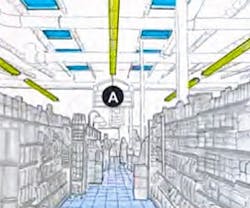The name "Commercial Lighting Solutions" sounds more like a corporate subsidiary than a new, free software product from the U.S. Department of Energy (DOE). In fact, it is a web-based lighting tool that DOE created last year to help facilities managers and others do accurate, quick calculations for energy-efficient lighting applications.
The interactive program is a back-of-the-envelope boost that can save building owners 30 percent more energy than the baseline standard ASHRAE 90.1 – without compromising the quality of illumination, say its creators.
Here’s how it works: First, users create an account on Commercial Lighting Solutions (CLS) and then build a virtual project by selecting building type, location, operating hours and applicable energy codes. (Currently, CLS supports retail and office facilities; more building types will be added down the road.) Second, the user describes the interior spaces, with inputs such as ceiling and partition heights, window arrangements, and solar control features.
Then comes the third and most powerful step: The DOE tool has a database of "design vignettes" – predefined lighting systems, basically – that can be selected from a menu. The database adds highly detailed information on fixtures and lamp components, daylighting strategies and controls options. Select a control strategy, and CLS automatically applies sensors and switches to the system. Need documentation? Voilà: CLS computes total energy savings over the baseline for each space, plus a full energy estimate for building with complete lighting specs.
"You can go through each of various space types to describe each space inside the building and the luminaires and controls used," says Geoff Elliott, a CLS developer with DOE’s Pacific Northwest National Laboratory (PNNL). "The downloads and energy summaries detail exactly where energy is being used."
Sound easy? In fact it is. But it may not answer every question about a lighting upgrade or design project, say skeptical lighting pros like Charles Cameron, chief lighting officer of Studio C Squared, New York City. "It’s always tough to create a simple tool for something that has so many different components. There’s no explanation of how a certain system design will make your space look, feel or function," contends the lighting designer, adding that he prefers the photometric modeling program Visual to get a more complete picture.
The creators of CLS agree, says Ruth Taylor, a manager of DOE lighting programs at PNNL. "Yes, we’re not saying our tool replaces the professional services of a lighting designer or engineer, but it’s a good place to start getting ideas to help give the design team very specific guidance," she notes.
More Web-Based Tools
Other lighting applications, including web-based tools, have also attempted to provide the convenience offered by CLS, according to the DOE. LightCalc, for example, quickly determines suitable footcandle levels, fixture spacing, and even suggests ceiling layouts for fixtures. It does not, however, show the relative efficiency of a given design. Focusing more on energy costs is Eco Lumen, a Windows-based program made in India designed to reduce lighting electricity bills by as much as 30 percent "while ensuring appropriate illumination levels in the facility" – based on India’s national standards.
While these lighting software tools won’t likely produce a full-fledged design for a new or upgraded space, they’ll help facilities managers plan for retrofits and new builds.
"There’s value in how the owner can pick up information ahead of time and see, for example, that yes, using occupancy sensors in the bathrooms will help reduce energy use," says Cameron. "The idea of simplified energy modeling is great because you have to design for some goal. So let’s see how the new lighting is going to stack up." Cameron adds that he has used a simple Excel spreadsheet to calculate energy savings, too.
With CLS users can also see how a new lighting scheme compares to key energy standards like ASHRAE 90.1 and even tax breaks like those in the Energy Policy Act, giving the DOE tool another edge. Building owners can exploit CLS to document upgrades that qualify for utility rebates or state and municipal incentives.
According to Elliott, CLS is just the beginning. DOE plans to roll out future technology solutions as part of the Net-Zero Energy Commercial Building Initiative. Why did lighting come first? The developers of CLS explain that lighting constitutes about 25 percent of the commercial sector’s energy use, making it the largest single draw. On top of that, it accounts for 42% of a commercial building’s cooling load.
"With client interest and stricter regulations, there’s more interest in energy efficiency, so you need someone to help you be more judicious in using those watts," Cameron sums up.
Motivated facilities managers can start using CLS in minutes by visiting www.lightingsolutions.energy.gov.
C.C. Sullivan ([email protected]) is a marketing communications consultant and writer specializing in architecture, design, and construction technology.
